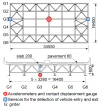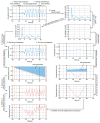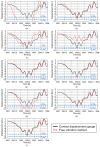Technique for Determining Bridge Displacement Response Using MEMS Accelerometers
- PMID: 26907287
- PMCID: PMC4801633
- DOI: 10.3390/s16020257
Technique for Determining Bridge Displacement Response Using MEMS Accelerometers
Abstract
In bridge maintenance, particularly with regard to fatigue damage in steel bridges, it is important to determine the displacement response of the entire bridge under a live load as well as that of each member. Knowing the displacement response enables the identification of dynamic deformations that can cause stresses and ultimately lead to damage and thus also allows the undertaking of appropriate countermeasures. In theory, the displacement response can be calculated from the double integration of the measured acceleration. However, data measured by an accelerometer include measurement errors caused by the limitations of the analog-to-digital conversion process and sensor noise. These errors distort the double integration results. Furthermore, as bridges in service are constantly vibrating because of passing vehicles, estimating the boundary conditions for the numerical integration is difficult. To address these problems, this paper proposes a method for determining the displacement of a bridge in service from its acceleration based on its free vibration. To verify the effectiveness of the proposed method, field measurements were conducted using nine different accelerometers. Based on the results of these measurements, the proposed method was found to be highly accurate in comparison with the reference displacement obtained using a contact displacement gauge.
Keywords: bridge health monitoring; free vibration separation method; measurement error; microelectromechanical systems accelerometer; vehicle detection.
Figures













Similar articles
-
Determination Method of Bridge Rotation Angle Response Using MEMS IMU.Sensors (Basel). 2016 Nov 9;16(11):1882. doi: 10.3390/s16111882. Sensors (Basel). 2016. PMID: 27834871 Free PMC article.
-
Refactoring and Optimization of Bridge Dynamic Displacement Based on Ensemble Empirical Mode Decomposition.Sensors (Basel). 2019 Jul 15;19(14):3125. doi: 10.3390/s19143125. Sensors (Basel). 2019. PMID: 31311190 Free PMC article.
-
Development of a Reference-Free Indirect Bridge Displacement Sensing System.Sensors (Basel). 2021 Aug 21;21(16):5647. doi: 10.3390/s21165647. Sensors (Basel). 2021. PMID: 34451089 Free PMC article.
-
Comparison of calibration methods for accelerometers used in human motion analysis.Med Eng Phys. 2016 Nov;38(11):1289-1299. doi: 10.1016/j.medengphy.2016.08.004. Epub 2016 Aug 31. Med Eng Phys. 2016. PMID: 27590920 Review.
-
Vehicle-Assisted Techniques for Health Monitoring of Bridges.Sensors (Basel). 2020 Jun 19;20(12):3460. doi: 10.3390/s20123460. Sensors (Basel). 2020. PMID: 32575359 Free PMC article. Review.
Cited by
-
A High-Speed Target-Free Vision-Based Sensor for Bus Rapid Transit Viaduct Vibration Measurements Using CMT and ORB Algorithms.Sensors (Basel). 2017 Jun 6;17(6):1305. doi: 10.3390/s17061305. Sensors (Basel). 2017. PMID: 28587275 Free PMC article.
-
A Wireless Data Acquisition System Based on MEMS Accelerometers for Operational Modal Analysis of Bridges.Sensors (Basel). 2024 Mar 26;24(7):2121. doi: 10.3390/s24072121. Sensors (Basel). 2024. PMID: 38610332 Free PMC article.
-
Mechanical Fault Diagnosis of High Voltage Circuit Breakers Based on Variational Mode Decomposition and Multi-Layer Classifier.Sensors (Basel). 2016 Nov 10;16(11):1887. doi: 10.3390/s16111887. Sensors (Basel). 2016. PMID: 27834902 Free PMC article.
-
The Great Wall Vibration Monitoring of Traffic and Natural Hazards Using MEMS Accelerometers.Sensors (Basel). 2023 Feb 15;23(4):2179. doi: 10.3390/s23042179. Sensors (Basel). 2023. PMID: 36850774 Free PMC article.
-
Monitoring of the Static and Dynamic Displacements of Railway Bridges with the Use of Inertial Sensors.Sensors (Basel). 2020 May 12;20(10):2767. doi: 10.3390/s20102767. Sensors (Basel). 2020. PMID: 32408682 Free PMC article.
References
-
- Fisher J.W. Fatigue and Fracture in Steel Bridges. 1st ed. John Wiley & Sons, Inc.; Hoboken, NJ, USA: 1984.
-
- Retrofitting Engineering for Fatigue Damaged Steel Structures. [(accessed on 15 December 2015)]. Available online: http://www.iiwelding.org/sites/Commission-XIII/WUDocuments/WIII-2284r2-1....
-
- Nassif H.H., Gindy M., Davis J. Comparison of laser Doppler vibrometer with contact sensors for monitoring bridge deflection and vibration. NDT&E Int. 2005;38:213–218.
-
- Yoneyama S., Kitagawa A., Iwata S., Tani K., Kikuta H. Bridge deflection measurement using digital image correlation. Exp. Tech. 2007;31:34–40. doi: 10.1111/j.1747-1567.2006.00132.x. - DOI
Publication types
LinkOut - more resources
Full Text Sources
Other Literature Sources

